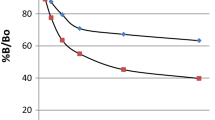Abstract
The newly synthesized125I-testosterone-3-carboxy-methyloxime-tyramide was tested for its applicability in protein binding methods. The binding of the radioactive steroid derivative to sex hormone binding globulin (SHBG), albumins and testosterone antibodies was examined. Furthermore the adsorption to florisil, charcoal and amberlite was studied. The results show:
-
1.
125I-testosterone is bound to antibodies obtained by immunization with testosterone-3-oxime-albumin conjugate similarly to3H-testosterone and unlabelled steroid.
-
2.
125I-testosterone and3H-testosterone show identical binding to florisil, charcoal and amberlite.
Therefore the125I-labelled hormone is suitable in competitive protein binding methods using testosterone antibodies and it can displace the tritium labelled hormone. Since125I-steroids have higher specific activities the sensitivity of the method is increased. Furthermore the practicability is enhanced. Special problems arise through the relatively short half-life of the isotope and the changing specific activity. Another difficulty is its decreased chemical stability when compared with the tritiated steroid.
Zusammenfassung
Wir untersuchten ein neu synthetisiertes125J-Testosteron-3-carboxy-methyloxim-tyramid auf seine Bindungsfähigkeit an Albumin, an das Sexualhormon-bindende Globulin und an Testosteron-Antikörper sowie die Adsorption des markierten Steroids an Florisil, Charcoal und Amberlit. Wir fanden:
-
1.
125J-Testosteron wird an Testosteron-Antikörper (erhalten durch Immunisierung mit Testosteron 3-oximalbumin) wie3H-Testosteron und unmarkiertes Testosteron gebunden.
-
2.
125J-Testosteron und3H-Testosteron werden gleichermaßen an Florisil, Charcoal und Amberlit gebunden.
125J-Testosteron kann daher bei radioimmunologischen Testosteronbestimmungen verwendet werden und kann das3H-Testosteron ersetzen. Da125J-Steroide eine höhere spezifische Aktivität haben, wird die Empfindlichkeit der Methode höher. Außerdem wird die Aufarbeitung einfacher. Ein Nachteil ist die relativ kurze Halbwertszeit von125J, welche die spezifische Aktivität ändert, und die verminderte Stabilität jodierter Steroide im Vergleich zu den Tritium-markierten Steroiden.
Similar content being viewed by others
Literatur
Anderson, D. C.: Clin Chim. Acta29, 513 (1970)
Furuyama, S., Mayes, D. M., Nugent, C. A.: Steroids16, 415 (1970)
Murphy, B. E. P.: J. Clin. Endocrinol.27, 973 (1967)
Wagner, R. K.: Z. Physiol. Chem.353, 1235 (1972)
Wiedemann, M., Raith, L., Wirtz, A., Karl, H. J.: diese Z.261, 382 (1972)
Author information
Authors and Affiliations
Additional information
Vortrag anläßlich der Tagung „Biochemische Analytik 74“, München, 22.–26.4.1974.
Rights and permissions
About this article
Cite this article
Wiedemann, M., Wirtz, A., Karl, H.J. et al. Untersuchungen über die Verwendung von125J-markiertem Testosteron bei Proteinbindungsmethoden. Z. Anal. Chem. 272, 195–198 (1974). https://doi.org/10.1007/BF00869177
Received:
Issue Date:
DOI: https://doi.org/10.1007/BF00869177




